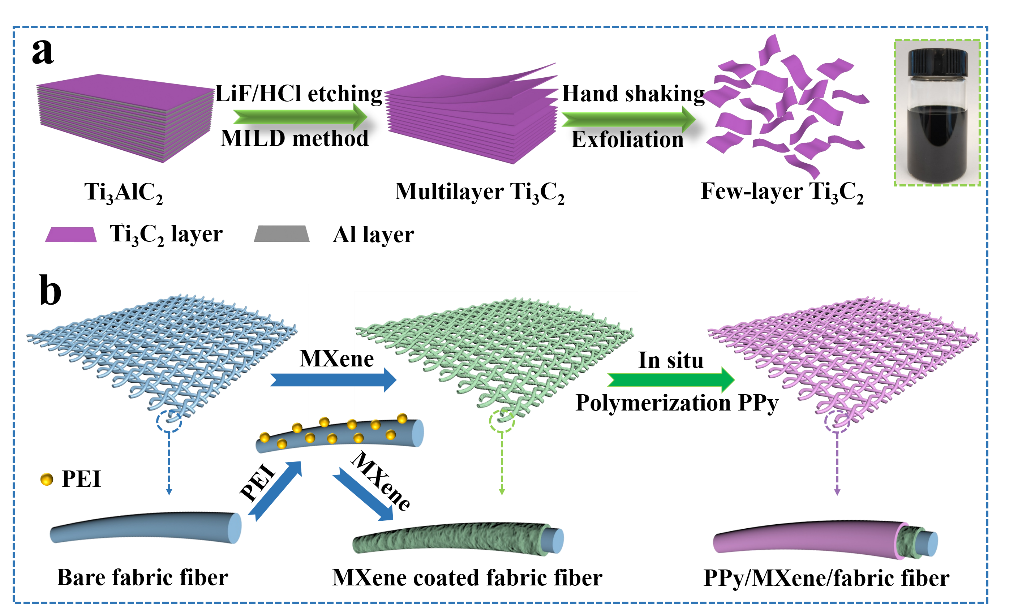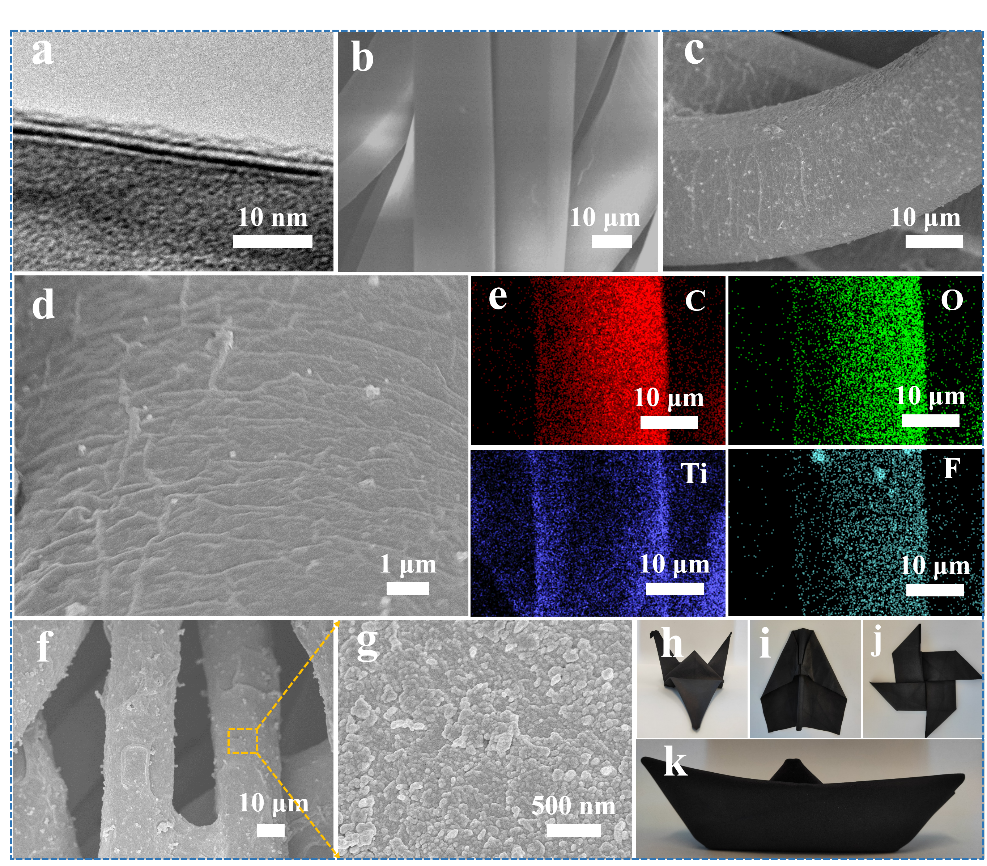Guide
High flexibility and wearability are considered important features of next-generation electronic products. Among the substrates for preparing flexible electrodes, fabrics with a three-dimensional structure are favored because of their advantages of high flexibility, large specific surface area, light weight, and mature preparation process. How to design a continuous electron transmission channel on an insulating textile substrate without compromising its inherent porous structure, flexibility, and stability is a major challenge in developing high-performance devices. Based on the above status, Professor Yuan Guohui from Harbin Institute of Technology, Professor Guo Zaiping from Wollongong University, and Dr. Liu Rong from Hebei Agricultural University published the title "Interfacing MXene flakes on fiber fabric as an ultrafast electron transport layer for high performance textile" in the internationally renowned journal Energy Storage Materials electrodes" paper. Dr. Li Xiaolong and Dr. Hao Junnan are the first authors of this article.

Figure 1. The graphic summary article proposes a simple method for preparing highly conductive fabric electrodes. Polyethyleneimine (PEI) modified positively charged polyester fabric and negatively charged titanium carbide MXene sheet attract each other to make The MXene sheet can be oriented and evenly loaded on the surface of the fabric fiber. Due to the surface chemical properties of MXene, they can not only form a continuous conductive skin layer, which is easy to charge and discharge at 10 V s -1, but also create many active sites for the further introduction of other electrochemically active materials. As a proof of concept application, the author polymerized pyrrole (PPy) on the conductive fabric as a supercapacitor electrode. The fabric electrode exhibited high area specific capacitance and high rate performance without sacrificing its mechanical properties. And excellent cycle stability. These characteristics show the great potential of the prepared electrode, and provide a new way for the design and development of other smart textiles.
Background Brief
1. The most intuitive and commonly used method to obtain the desired conductive textile is to reduce the high-conductivity nanomaterials with low dimensional and high specific surface area, such as one-dimensional (1D) carbon nanotubes and two-dimensional (2D) reduced graphite oxide Rene (rGO) is introduced onto the textile substrate. However, previous studies have shown that the introduced carbon nanotubes are easily detached from the surface of the fabric fiber. Due to the weak van der Waals force between it and the fabric substrate, the few layers of rGO will inevitably produce wrinkles, which is not conducive to rGO and Fabric fibers form tightly fitting conductive paths. Similarly, in most of the current research reports, the nano-carbon materials introduced in the fabric substrate are randomly distributed, making it difficult to form a continuous electron transmission network. Although the surface chemical modification improves the binding force between the nano-carbon material and the fabric fibers, the conductivity is greatly reduced due to the introduction of surface functional groups. In order to compensate for the relatively low electron conduction and achieve rapid charge and discharge, the mass load of the nano-carbon material in the fabric substrate is often increased to a few milligrams per square centimeter, or even dozens of milligrams per square centimeter, which seriously damages its cost and flexibility , Washing resistance and stability (due to the shedding of active materials during deformation). More importantly, the aggregation and accumulation of nano-carbon materials in the porous fabric inhibits ion transport within the composite electrode, especially at high current densities, reducing the contact surface area between the electrode material and the electrolyte. In addition, the limited specific surface area is not conducive to the further loading of other high-performance electrochemically active functional materials. Therefore, the unique performance of the fabric electrode is impaired or unavailable in wearable devices. Therefore, designing the ideal solid-solid interface and low mass load between the conductive material and the fabric fiber is the key to the high-performance electrode technology.
2. Introduction to MXenes This is a new two-dimensional transition metal carbide and nitride material. Its general formula is Mn+1XnTx, where M represents transition metal, X represents carbon or nitrogen, n = 1, 2 or 3, Tx represents various surface functional groups (for example, -O, -OH, and -F). So far, various applications of MXene in supercapacitors, various ion batteries, sensors, electromagnetic interference shielding, selective ion sieves, cell imaging, and other devices have attracted widespread attention. This is due to their high electrical conductivity (equivalent to 10000 S cm-1 film), layered structure, large specific surface area, hydrophilic surface and relatively good chemical stability. Due to the natural hydrophilicity and mutual repulsion between MXene nanosheets, they are easily dispersed in water to form nanosheets. In addition, Ti3C2Tx MXene has good biocompatibility and does not cause corresponding risks when it comes into contact with the skin, so it is suitable for the design of wearable electronic products. The unique physical structure and chemical surface of Ti3C2Tx-MXene enable us to develop MXene-based conductive textiles.
core content
In this work, the authors used polyethyleneimine (PEI) modified positively charged fabric electrodes and negatively charged Ti3C2Tx-MXene nanosheets to prepare a highly flexible and highly conductive method through electrostatic self-assembly Fabric electrode. Previous studies have shown that PEI can covalently interact with various materials. Therefore, PEI is used as a positive charge treatment agent to provide chemical and mechanical stability for textile electrodes. After electrostatic assembly, the MXene sheet can be evenly coated on the fabric fiber surface to form a continuous conductive surface layer. This structure shortens the ion diffusion distance and makes ion transmission faster. Therefore, the MXene / PEI modified fabric electrode (MXene / PMFF) exhibits ultra-high rate performance, with almost no attenuation in the current density range of 1-50 mA cm-2, and can be as high as 10 V s-1 Charge/discharge at the sweep speed. Although individual 2D MXene fabric electrodes exhibit some desired characteristics, they cannot provide all the characteristics required by different devices (such as supercapacitors), such as maximizing energy density, power density and cycle life. MXene/PMFF fabric electrode has a large number of surface functional groups, continuous conductive network, porous structure and good processability, making it a promising flexible substrate for the loading of other high pseudocapacitive active materials. The author synthesized PPy/MXene/PMFF supercapacitor electrodes by polymerizing pyrrole (PPy) on MXene/PMFF through in-situ polymerization. The good interface structure formed between the MXene/PMFF flexible substrate and PPy gives the fabric electrode excellent electrochemical performance, including high area specific capacitance (1295 mF cm-2), mass specific capacitance (439 F g-1), Rate performance (82% capacity retention rate from 1 to 50 mA cm-2 ), cycle performance (capacity retention rate after 30,000 cycles of 94.8%), and excellent mechanical properties ensure that almost all of them are maintained under various deformation conditions Change in electrochemical performance. The all-solid symmetric supercapacitor assembled with PPy/MXene/PMFF fabric electrodes exhibits a large area specific capacitance of 458 mF cm-2, and the maximum area energy density is 40.7 μWh cm-2, and the area power density is 25 mW cm- 2.
 (a) TEM image of MXene. SEM images of
(a) TEM image of MXene. SEM images of
(b) PMFF and
(c,d) MXene/PMFF.
(e) EDS mappings of C, O, Ti, and F for MXene/PMFF. (f,g) SEM images of PPy/MXene/PMFF.
(h–k) Photographs of PPy/MXene/PMFF electrodes with flexible, rollable and foldable properties.
Article link:
Interfacing MXene flakes on fiber fabric as an ultrafast electron transport layer for high performance textile electrodes
https://www.sciencedirect.com/science/article/abs/pii/S2405829720301768
Source of information: Scientific Materials Station
This information originates from the Internet for academic exchange only. If there is any infringement, please contact us to delete it immediately




 (a) TEM image of MXene. SEM images of
(a) TEM image of MXene. SEM images of